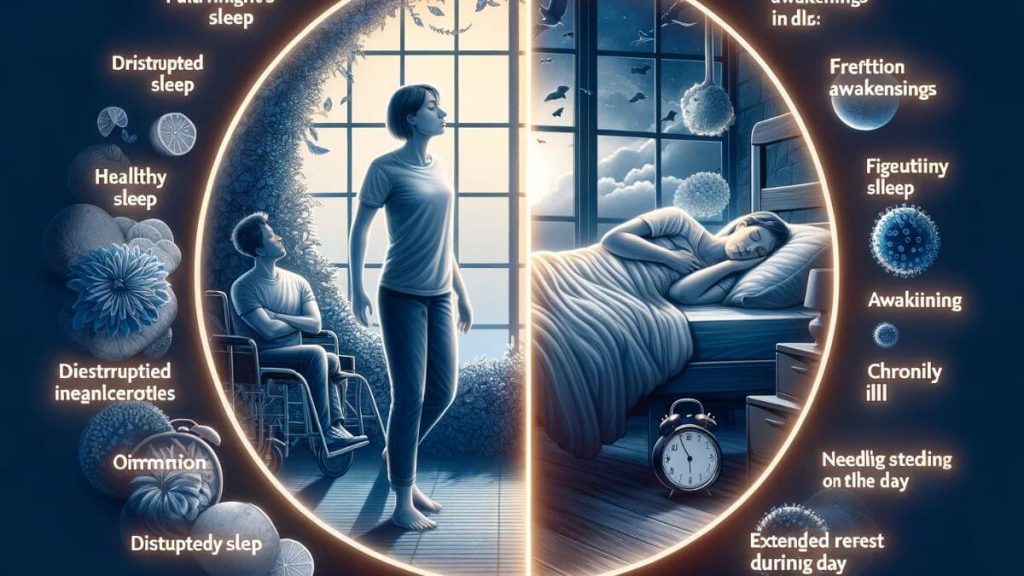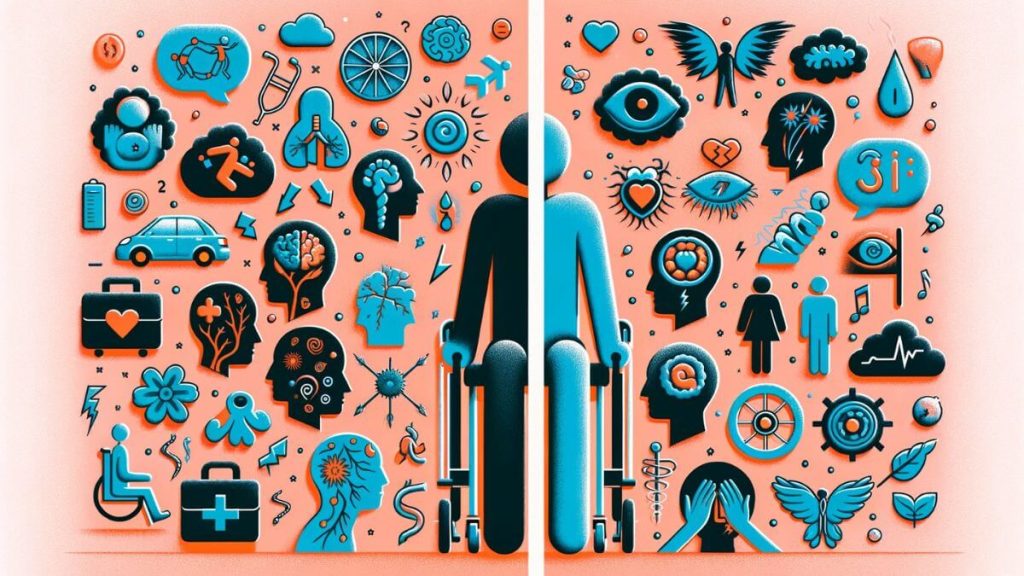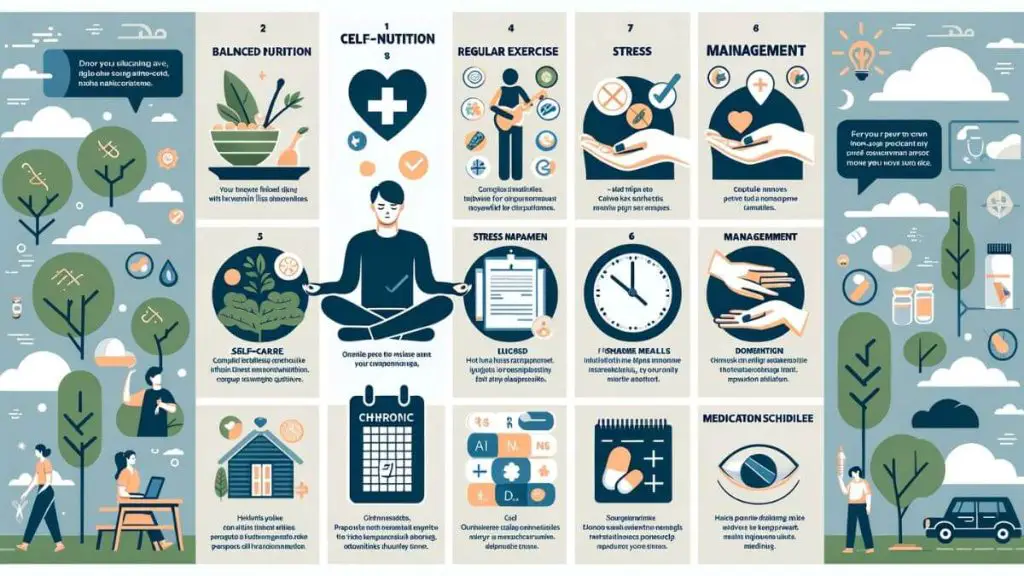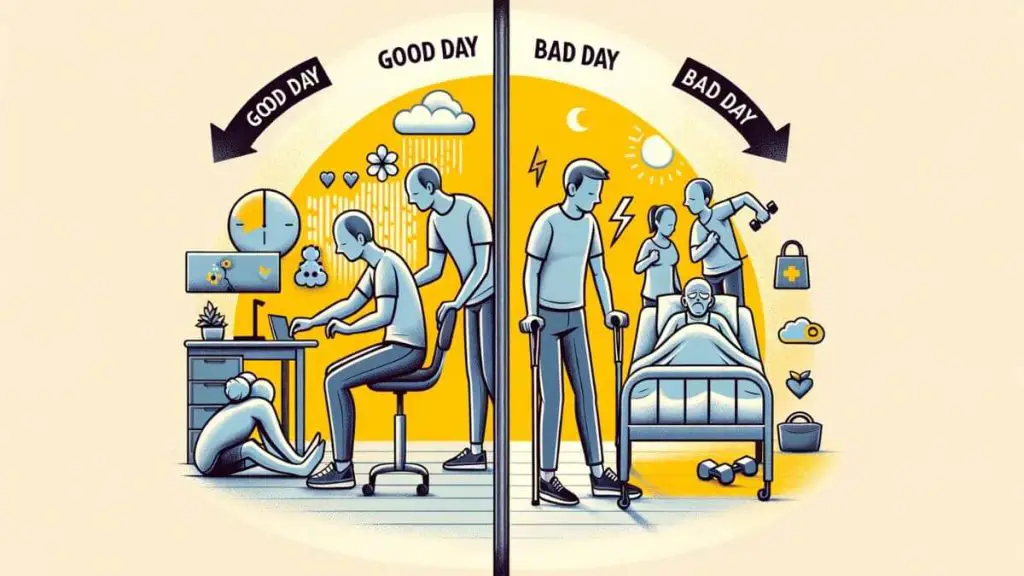How to Make Healthy People Understand Your Chronic Illness?
My wife struggles to this day with the lack of understanding of her endometriosis and fibromyalgia by others, and this is why I decided to write this article – to answer the question – “How to Make Healthy People Understand Your Chronic Illness?”
To help healthy people understand your chronic illness, it’s important to communicate openly and provide information about your condition, its symptoms, and its impact on your daily life. Educate them about the challenges you face and the support you may need, fostering empathy and awareness.
- How to Make Healthy People Understand Your Chronic Illness?
- Understanding Chronic Illness, its Definition and Impact
- Breaking Down Chronic Illness Misconceptions
- Communicating Your Chronic Illness to Others
- How to Make Healthy People Understand Your Chronic Illness
- Practical Strategies for Educating Healthy Individuals
- Building a Support Network for Continuous Care
- Handling Reactions and Misunderstandings About Your Illness
- Creating an Environment of Empathy and Support
- Chronic Illness and Mental Health: Seeking Help
- Self-Care and Management of Chronic Diseases
- How to Explain the Lingo of Chronic Illness to Healthy People
- Talking to Healthy Individuals About Chronic Illness Safety and Emergencies
- Source Links to How to Make Healthy People Understand Your Chronic Illness
How to Make Healthy People Understand Your Chronic Illness?
Living with a chronic illness can feel like a lonely journey, but it doesn’t have to be. With the right chronic illness education, you can bridge the gap and foster greater understanding among those without your experience.
This starts by learning how to make healthy people understand your chronic illness. Whether it’s sharing the nuances of your daily life, or offering insight into the emotional and physical complexities, building understanding for chronic illness is essential.
Explaining chronic illness to others can open doors to the support you not only desire but also deserve. Let’s explore this together and ensure that your voice is heard and your condition is understood.
If you want more in-depth information about how to support your partner with her chronic conditions and how to cope with the new normal in your relationship, I wrote a “Supporting a Chronically Ill Partner” e-Book.
You can get the 1st Chapter of the e-Book for FREE, and if you like it, you’ll get a Whopping 33% Discount on the Whole Book, plus discounts on other helpful tools. You have nothing to lose but a lot to gain!
The first chapter alone contains a lot of information for both of you about acknowledging the struggles, including:
- A word to your partner.
- A word to you.
- Stepping on eggshells.
- Understanding her needs.
- How to acknowledge having a chronically ill partner?
- Acknowledging can be hard.
- 15 tips on how to do it!
Get the 1st Chapter FREE!
Chronic Illness for Partners

Understanding Chronic Illness, its Definition and Impact
When you or a loved one is diagnosed with a chronic illness, it signifies the onset of a journey that alters the outlook on health and daily living. Recognizing the essence of these conditions is pivotal in explaining chronic illness to others and cultivating a supportive community.
What Constitutes a Chronic Illness?
At the core of the term chronic illness is its persistence; these are health conditions that stretch beyond a year and mandate ongoing medical attention. They often impede regular routines and challenge an individual’s ability to perform daily tasks independently. From the respiratory constraints of asthma to the intricate blood sugar management in diabetes, chronic conditions are as varied as they are impactful.
The Daily Struggles and Activities of Living with Chronic Illness
The daily struggles with chronic conditions encompass a spectrum of tasks that many take for granted. Simple activities like grocery shopping, household chores, or even personal grooming can become formidable endeavors. These challenges not only affect physical well-being but also have profound implications on mental health.
Physical and Emotional Effects of Chronic Conditions
The emotional effects of chronic illness are profound, with many facing stress, depression, and anxiety due to their altered capacities and the ongoing nature of their condition. The physical changes that accompany chronic diseases can impact one’s self-image and overall emotional state, manifesting a complex web of feelings that family and friends need to acknowledge and understand.
Informing yourself and those around you about these complexities is a crucial part of the journey. Sharing your story can be both therapeutic for you and enlightening for others, fostering an empathetic understanding that paves the way for genuine support.
| Aspect | Effects on Daily Living | Emotional Implications |
|---|---|---|
| Physical Limitations | Difficulty performing household tasks, need for assistive devices | Feelings of dependency, frustration over lost autonomy |
| Work and Finance | Potential loss of employment, increased medical expenses | Financial stress, concerns about future stability |
| Social Interactions | Navigating accessibility, planning around medical needs | Social isolation, fear of being a burden |
| Self-Care and Appearance | Altered personal routine, impact on physical appearance | Sense of identity loss, lowered self-esteem |

Breaking Down Chronic Illness Misconceptions
When you’re living with a chronic illness, you might find yourself grappling not only with the illness itself but also with pervasive misconceptions. By raising awareness about chronic illness and actively advocating for chronic illness awareness, you can help others understand the differences between media portrayals or common myths and the reality of daily life with a chronic condition. This understanding is essential for building a society that is supportive and caring towards those affected.
One of the most enduring chronic illness misconceptions is that these conditions can be easily managed or even cured. This myth fails to account for the complex, often unpredictable nature of chronic conditions and the ongoing adjustments they require. Let’s examine some of these misconceptions and the truths behind them:
- Myth: Chronic illnesses are not as serious as acute illnesses.
- Truth: The ongoing nature of chronic illnesses can lead to a significant impact on overall health and wellbeing.
- Myth: A person with a chronic illness looks sick.
- Truth: Many with chronic conditions often appear ‘well’ despite experiencing symptoms that disrupt their daily lives.
- Myth: Lifestyle changes alone can resolve chronic illnesses.
- Truth: While healthy habits can help manage symptoms, most chronic conditions require medical treatment and cannot be overcome by lifestyle adjustments alone.
- Myth: If you have a chronic illness, you cannot lead a productive life.
- Truth: Many people with chronic conditions are able to work, participate in their communities, and enjoy hobbies, though they may need modifications or support to do so.
Spreading accurate information about living with a chronic illness is crucial. If you’re looking to educate others, consider sharing your own experiences or support campaigns that advocate for chronic illness awareness. Encouraging open dialogues helps to eliminate stigma and promote a more understanding environment for everyone.
Remember, your voice matters. Whether through conversations with friends and family or through broader advocacy platforms, you can be part of the change that dismantles harmful stereotypes and champions the resilience of individuals living with chronic illnesses every day.
Communicating Your Chronic Illness to Others
When it comes to communicating your chronic illness, sharing your journey isn’t just about personal transparency; it’s a powerful gesture of chronic illness education that can forge stronger bonds with the people around you. It’s how you can help others step into your shoes, even if just for a moment, to glimpse the reality of living with a persistent health condition.
Why It’s Important to Share Your Experience
You might wonder why sharing chronic illness stories is crucial. Speaking out bridges gaps of understanding and cultivates a sense of community. Your voice can illuminate the hidden struggles of chronic conditions, paving the way for empathy, support, and potentially better policies that accommodate people with long-term health issues.
Choosing When and How to Disclose Your Condition
Deciding on disclosing chronic conditions is a deeply personal choice, and there is no one-size-fits-all approach. Ease into these conversations when you feel the time is right, and do so in settings where you feel safe and listened to. Whether you’re seeking accommodations in the workplace or simply desiring a supportive ear, how and when you disclose your illness should be entirely up to you.
Your honesty in communicating chronic illness not only educates but also invites cooperation and perhaps inspires others to share their own stories. So, take heart, take control, and let your truth be heard.
| Consideration | Workplace | Social Circle |
|---|---|---|
| Comfort Level | Disclose based on the need for accommodations | Share when you feel it will foster understanding |
| Safety | Review company policies on health disclosures | Choose trusted friends who respect your privacy |
| Support Needs | Communicate to HR or trusted colleagues | Lean on close friends or support groups |

How to Make Healthy People Understand Your Chronic Illness
Understanding a chronic illness can be a complex journey for those who’ve never experienced it. Your task in bridging the gap between healthy individuals and chronic illness is pivotal. Begin by crafting a narrative around the everyday realities of your condition. It’s not just about the symptoms; it’s about the impact on your life. For instance, express the challenges you face during a flare-up and how it may disrupt your typical routine. This transparency fosters chronic illness support from the people around you.
Remember, patience is a virtue. When you engage in open conversations about your health, take a proactive stance. Employing practical examples to describe your lived experiences can make abstract concepts more tangible. If appropriate, a dash of humor can lighten the mood and facilitate a more receptive environment for understanding your chronic illness.
- Be honest about the unpredictable nature of your condition.
- Share real-life stories and scenarios that highlight your daily struggles.
- Discuss the emotional and social effects of living with a chronic illness.
- Explain how your condition might require certain accommodations or adjustments.
Moreover, creating an engaging table can help illustrate the varying degrees of chronic illness impacts. This visual can serve as an informative tool to better convey your message:
Be assured that it is possible to cultivate a nurturing environment through communication and education. While explaining how to make healthy people understand your chronic illness, the key is consistency and clarity. By doing so, you are not just advocating for yourself but also for the many who are silently managing their conditions, striving for chronic illness support and comprehension.
| Aspect of Life | Impact of Chronic Illness | What Healthy Individuals Can Do to Support |
|---|---|---|
| Work | May need to take frequent breaks or have flexible hours | Understand the need for adjustments in work duties or schedules |
| Social Activities | May cancel plans last-minute due to sudden flare-ups | Show compassion when plans change and offer low-energy alternatives |
| Household Responsibilities | Difficulty with physical tasks | Offer help with chores or errands to ease the burden |
| Emotional Well-being | Strong feelings of stress or anxiety | Provide a listening ear and validate experiences |
Practical Strategies for Educating Healthy Individuals
Understanding chronic conditions is not an intuitive process for everyone. However, the power of human connection through sharing can break barriers and illuminate the realities of living with a chronic illness.
By engaging in chronic illness education, you employ constructive strategies to inform and inspire those around you. Let’s delve into the effectiveness of utilizing storytelling and the pivotal role of advocating for chronic illness awareness.

Utilizing Storytelling as an Educational Tool
Imagine transforming your personal journey with a chronic illness into a narrative that compels and educates. Storytelling is a profound method for educating healthy individuals.
When you share the ebb and flow of your daily life, you open a window to your world that can change perceptions. Whether it’s recounting a day marked by unseen struggles or a moment of triumph, storytelling personalizes the chronic illness experience and cultivates empathy.
- Identify your narrative: Craft your story in a way that’s both true to your experiences and relatable to your audience.
- Encourage dialogue: After sharing, invite questions and discussions to foster better understanding.
- Include the silver linings: While acknowledging the hardships, also highlight the lessons and strengths gained through your journey.
Importance of Advocating for Chronic Illness Awareness
Beyond sharing your story, stepping into an advocacy role can exponentially increase the impact of your efforts. When you advocate for chronic illness awareness, you’re not just speaking for yourself but also for the community that shares your experiences. You become a beacon for change in societal attitudes and health care practices. Advocacy doesn’t have to be grandiose—it starts with conversations, community involvement, and raising awareness in everyday encounters.
Empower yourself and others by embracing these approaches to chronic illness education. Utilize the profound impact of your voice and narratives to carve a path of understanding in the minds of healthy individuals. Remember, each story shared is a crucial step toward a world where chronic illness is recognized, and the invisible is made visible.
| Action | Brief Description | Impact |
|---|---|---|
| Education Sessions | Organize informative talks at community centers. | Increases local understanding and compassion. |
| Social Media Campaigns | Use platforms to share facts and personal anecdotes. | Reaches a wide audience and can go viral. |
| Policy Advocacy | Lobby for better health care policies and support systems. | Can lead to significant changes in how chronic illnesses are managed and funded. |
Building a Support Network for Continuous Care
Embarking on your journey with a chronic illness is not a path you should walk alone. Establishing a robust support network is a linchpin for your continuous care, providing not just practical assistance, but also emotional solace. Remember, chronic illness support takes many forms, and creating a diversified network can greatly augment your quality of life.
Finding the Right Support Groups and Counseling
Finding counseling for chronic illness and connecting with support groups can be instrumental in managing your condition. Support groups bring together individuals facing similar challenges, allowing you to exchange stories, coping strategies, and invaluable companionship—confirming that you are far from being alone in your struggles.
Counseling, on the other hand, offers a private setting where you can grapple with the more profound impacts of your illness on your life and relationships. With professional guidance, you can unearth personalized strategies to navigate the complexities of life with a chronic condition.
Incorporating Family and Friends in Your Support System
Do not underestimate the strength that family involvement contributes to your support system. While friends and peers offer relatability and understanding, your family can provide an unparalleled level of intimate support and advocacy. Your loved ones can play multiple roles—caregivers, cheerleaders, or educators to others about your condition.
By engaging your family, you’re not only reinforcing your everyday support but also nurturing an environment where both understanding and patience flourish.
Remember, every voice in your support network is a beacon of encouragement, aiding you in weathering the tempests caused by chronic illness. Take the initiative, reach out, and weave a tapestry of support rich with camaraderie, professional aid, and familial care. It’s within this network that you’ll find the strength to embrace each day with hope and determination.

Handling Reactions and Misunderstandings About Your Illness
When you reveal your chronic illness to others, the array of reactions can be as varied as the conditions themselves. Some people might express shock, while others may inadvertently say something insensitive, not out of malice, but from a lack of understanding. Handling reactions to chronic illness is not about expecting perfection, but about fostering an ongoing dialogue that can grow from initial reactions to informed discussions and support.
Patiently correcting misunderstandings about chronic illness is part of this process.
As you educate those around you, it’s helpful to come equipped with the understanding that everyone’s learning curve is different. You might find yourself repeating information or reassessing the best ways to convey your needs. Yet, it’s these repetitive moments of chronic illness education that lay the foundation for deeper understanding and awareness.
- Listen actively when others voice their thoughts, and use these opportunities to guide the conversation towards a more informed perspective.
- Communicate your needs clearly — let others know what support looks like for you.
- Be open to questions, and answer them candidly — this encourages a setting where no one is afraid to ask or learn more.
- Remember to acknowledge that while your illness is a part of your life, it does not define your entirety. You seek normalcy and inclusion, not pity.
Your journey is not a solo venture. By inviting others into your world with kindness and education, you can transform initial reactions into enduring empathy and assistance. With each conversation, the gap narrows, and those who once knew little about living with a chronic illness can become some of your strongest allies and advocates.
Creating an Environment of Empathy and Support
Creating a nurturing space where empathy and support interweave involves more than just informing others; it requires opening hearts through sharing and understanding.
When you bring your personal narratives into the conversation, you provide a vivid glimpse into your life with a chronic illness, helping others to step into your shoes, if only for a moment. It’s these snippets of your daily experiences that can deeply resonate with others, catalyzing the empathy and support which can be so fundamental to your wellbeing.
Encouraging Empathy Through Personal Stories
Imagine a world where your struggles are not just seen but felt by those around you. By sharing personal stories, you become a storyteller of your own life, casting the spotlight on the realities—both the triumphs and trials—of chronic illness. Empathy blooms from understanding, and your stories serve as the roots. Whether it’s recounting a day of overwhelming fatigue or a moment of resilience, these narratives are paramount in nurturing empathy.
Bridging the Communication Gap Between Different Health States
You possess the unique power to bridge the communication gaps that often exist between different health states. Through dialogue and sharing, you can illuminate the shadows of misunderstanding that might linger around chronic illness.
By helping others understand chronic illness, you are not just advocating for yourself but for a world where every health journey is acknowledged and met with support. Remember, your voice is the bridge—connect through storytelling and watch the gap narrow, one story at a time.

Chronic Illness and Mental Health: Seeking Help
When chronic illness enters your life, it brings not just physical challenges but also mental health hurdles. The intertwining of chronic illness and mental health cannot be overlooked, making it essential to recognize stress signals and manage depression. Prioritizing your mental health is as important as managing your physical symptoms, for they are deeply interconnected. Below are actionable steps and considerations for maintaining your mental well-being while battling a chronic condition.
Recognizing Stress Signals and Seeking Professional Help
Stress can manifest in various forms when dealing with chronic illness. It’s vital to be vigilant and recognize the early signs of stress to prevent them from exacerbating into more severe mental health issues. Symptoms like persistent irritability, constant fatigue, and sleep disturbances are red flags signaling the need for professional intervention.
Don’t hesitate to reach out to mental health professionals who are trained to help you navigate through these challenges. Here’s a guide to help you identify stress signals:
Identifying these signals early can prompt you to seek professional help, which can include counseling, stress management strategies, and medication if necessary.
| Emotional Signals | Physical Signals | Behavioral Signals |
|---|---|---|
| Mood swings | Headaches | Withdrawal from social activities |
| Frustration and feelings of overwhelm | Stomach disturbances | Changes in eating habits |
| Anxiety or depression | Muscle tension | Neglected responsibilities |
Managing Depression and Anxiety Associated with Chronic Illness
Depression and anxiety are common companions of chronic illness. The emotional toll of coping with a long-term health condition can lead to feelings of helplessness and isolation. If you find yourself struggling with depression or anxiety, remember that these are valid and common reactions that require and deserve attention. Here are some strategies to help manage these feelings:
- Engage in regular physical activity tailored to your abilities to boost endorphins.
- Maintain social connections to provide a network of support.
- Practice mindfulness and relaxation techniques like meditation or deep-breathing exercises.
- Seek counseling or therapy for personalized strategies and coping mechanisms.
- Consider medication under the guidance of a healthcare provider to regulate mood.
Remember, taking care of your mental health is a critical component of managing chronic illness. By recognizing stress signals early and seeking appropriate help, you set the stage for a more balanced and fulfilling life.

Self-Care and Management of Chronic Diseases
Adopting a regimen of self-care is imperative in navigating the complexities of chronic diseases. Not only does it empower you in your health management for chronic diseases, but it also instills a sense of control and well-being. Let’s explore how you can maintain a healthy lifestyle and integrate effective stress-relief activities into your life, despite the challenges posed by chronic illnesses.
Maintaining a Healthy Lifestyle Despite Chronic Illness
Living with a chronic condition doesn’t mean putting your life on hold. Instead, it’s about adapting and creating a balanced lifestyle that supports your health. Focus on nutritious eating, which fuels your body and can help manage symptoms. Regular exercise tailored to your abilities can improve physical function and mood.
Be mindful of sleep patterns, as restorative sleep is a cornerstone for a healthy lifestyle. And remember, hydration is your ally. While it’s tempting to fall back on unhealthy habits, remember that your choices today shape your wellness tomorrow.
Effective Stress-Relief Activities for Better Health Management
- Meditation and mindfulness can clear your mind and reduce anxiety.
- Gentle yoga or tai chi incorporates movement with stress reduction.
- Creative outlets like art or music provide a therapeutic escape.
- Spending time in nature can boost your mood and create a sense of peace.
- Aromatherapy with essential oils may offer a calming effect.
- Connecting with friends and support groups can diminish feelings of isolation.
By implementing these self-care for chronic illness strategies, you encourage not just physical, but emotional resilience. Let each day be a step towards your empowerment.
How to Explain the Lingo of Chronic Illness to Healthy People
Entering the world of chronic illness can sometimes feel like crossing into a country where the language is peppered with terms that baffle the uninitiated. It’s your role to serve as a translator, taking complex chronic illness terminology and breaking it down into everyday language. Here’s how you can approach explaining chronic illness to others to enhance their understanding and boost chronic illness education.
| Chronic Illness Term | Definition | Simplified Explanation |
|---|---|---|
| ANA Testing | Antinuclear antibody testing | A test that checks for autoimmune diseases |
| Brain Fog | Cognitive dysfunction involving memory, attention, and concentration difficulties | When it feels harder to think clearly or remember things |
| Hypothyroidism | A condition where the thyroid does not produce enough thyroid hormone | The thyroid gland isn’t as active as it should be, affecting energy and metabolism |
| Fibromyalgia | A disorder characterized by widespread musculoskeletal pain | A condition that causes pain all over the body, fatigue, and tenderness |
| Flare-Up | A sudden increase in symptoms of a disease or condition | A period when symptoms get worse or more intense |
As you delve into discussions about your health, keep in mind that you’re not just explaining chronic illness to others; you’re inviting them to understand a significant part of your life. This is where the lingo of chronic illness comes into play. You have the power to shape their perceptions and awareness with your words.
- Start with familiar concepts. Draw analogies to experiences that most people can relate to, making abstract symptoms more tangible.
- Be patient and open to questions. Encourage a dialogue where it’s okay for others to ask for clarification.
- Share resources or visuals that could help in understanding complex medical terms or conditions.
Remember, by educating those around you, you’re promoting a world where the language of chronic illness is not a barrier, but a bridge to deeper empathy and connection.

Talking to Healthy Individuals About Chronic Illness Safety and Emergencies
When it comes to chronic illness safety, one of the most proactive steps you can take is educating the healthy individuals in your life about your condition.
Understanding the intricacies of health concerns and interventions not only prepares them to offer you support but also equips them with the knowledge to act decisively during potential health crises. It’s all about creating an informed circle of friends, family, and colleagues who can confidently navigate the delicate aspects of your well-being.
Educating Others on Your Specific Health Concerns and Interventions
Your health concerns are unique, and so is the care required to manage them. Sharing specifics about your chronic illness, including triggers, symptoms, and the nature of potential emergencies, fosters an informed environment.
Detailing how to administer important interventions, like glucose tablets for hypoglycemia in diabetes or using an EpiPen in case of severe allergies, empowers those around you to become active participants in your chronic illness safety net.
How to Prepare Others for Potential Health Crises
Preparing for health crises involves more than just theoretical knowledge; it’s about practical readiness. Consider running through hypothetical scenarios with your support system and discussing detailed plans of action. By educating others on emergencies, you’re not only safeguarding your personal health but also instilling confidence and calm in those who may be pivotal during challenging moments. Remember, the goal is to ensure that everyone is on the same page when it comes to your health and safety.


About Me
Hi, I’m Lucjan! The reason why I decided to create this blog was my beautiful wife, who experienced a lot of pain in life, but also the lack of information about endometriosis and fibromyalgia for men…
